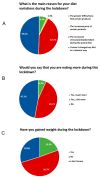Covid-19 and the Subsequent Lockdown Modified Dietary Habits of Almost Half the Population in an Italian Sample
- PMID: 32466106
- PMCID: PMC7278864
- DOI: 10.3390/foods9050675
Covid-19 and the Subsequent Lockdown Modified Dietary Habits of Almost Half the Population in an Italian Sample
Abstract
The Covid-19 pandemic led to lockdowns in several parts of the world and, hence, changed some daily habits, including social interactions, the ability to perform sports, and-possibly-diet. The Italian government established and promulgated lockdown policies on 9 March 2020. We aim at assessing the effects of Covid-19-induced confinement policies on self-reported food consumption of self-selected Italians by means of a questionnaire that was created and diffused by the Internet. Nearly half, i.e., 49.6% of responders did not substantially modify their diet during the lockdown; however, 46.1% of them reported that they were eating more during confinement, and 19.5% gained weight. In particular, we report an increase in "comfort food" consumption, notably chocolate, ice-cream, and desserts (42.5%) and salty snacks (23.5%). In addition, 42.7% percent of this cohort attributed this increase to higher anxiety levels. Related to this, 36.8% of responders reported a decrease in alcohol consumption, even though 10.1% of them reported an increase. Interestingly, 21.2% of responders increased their consumption of fresh fruit and vegetables. Only 33.5% of those who declared decreased consumption attributed this change of diet to lower availability and ease of purchasing such items. Equally interesting, over half of responders, i.e., 56.2%, admitted that fruit and vegetables did not appeal to them while in lockdown. Purchases of ready-made meals were reduced by nearly 50%. Future large-scale similar studies should be undertaken worldwide and will help public health authorities shape their reactions to future, unavoidable pandemics.
Keywords: Covid-19; diet; dietary habits; food availability; lockdown.
Conflict of interest statement
The authors declare no conflict of interest associated with this study.
Figures
References
-
- Willett W., Rockstrom J., Loken B., Springmann M., Lang T., Vermeulen S., Garnett T., Tilman D., DeClerck F., Wood A., et al. Food in the Anthropocene: The EAT-Lancet Commission on healthy diets from sustainable food systems. Lancet. 2019;393:447–492. doi: 10.1016/S0140-6736(18)31788-4. - DOI - PubMed
LinkOut - more resources
Full Text Sources
Medical




